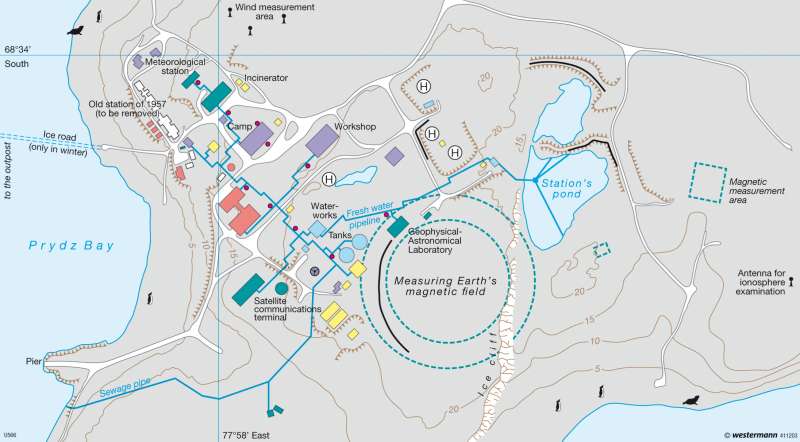Davis — Australian Antarctic station
The world - Polar regions
978-3-14-100790-9 | Page 171 | Ill. 4

Information
In 1911, Roald Amundsen and his team reached the South Pole. Prior to that there had been several unsuccessful attempts to reach the Pole, which was one of the last untrodden places on Earth. Especially dramatic was the failure of the British expedition led by Robert Falcon Scott, which arrived at the Pole shortly after Amundsen.A century later the fact that people spend time in hostile Antarctica is taken for granted. More than 20 countries operate some 80 research stations, distributed throughout the continent in varying concentrations. A particularly heavy concentration is to be found in the Antarctic Peninsula, lying to the south of South America. At the most remote location, directly at the South Pole, the USA has operated the Amundsen-Scott Station since 1957.
The Davis Antarctic Station
The segment of Antarctica lying closest to Australia in the Indian Ocean is claimed by Australia. Here, on the coast of Princess Elizabeth Land which was discovered in 1931, Australia operates the Davis Antarctic Station. It is located on the 68° 35' latitude and was opened in 1957 on the occasion of the International Geophysical Year. It is situated between the Sørsdal Glacier in the south, the slopes rising up to the continental plateau 24 kilometres distant in the east, and the sea in the north-west. Off the coast there are numerous small islands, and with a land area of some 400 square kilometres it is the largest ice-free coastal region on the Antarctic land mass. Permafrost nevertheless reigns, and for some seven months a year the ground is covered by snow.
The surroundings of Davis justify its choice as the site for a research station: as well as fresh water lakes there are also lakes with extremely salty water, which does not freeze even at temperatures of —18 °C, and provides a habitat for microscopically small invertebrates. In addition there are colonies of Adelie penguins and Weddell seals in the vicinity.
In the early days of Davis, only between four and ten people stayed at the station for the winter. Since the end of its closure between 1965 and 1969, Davis has been permanently inhabited. In the 1980s the old buildings were abandoned and replaced by steel constructions on concrete foundations. Fresh water from a lake is diverted to the various station complexes through a network of pipes via a waterworks and tanks. There is accommodation for up to 70 people who work at Davis in the summer season. In winter some 20 researchers live at the station.
The station has numerous measurement facilities including a meteorological station and a wind gauge. There is also a geophysical-astronomical laboratory, magnetic field measurement, and a facility for observation of the ionosphere. Links to the outside world are ensured by a helicopter pad and a satellite communication facility. An important facility is the incineration oven for the disposal of waste.
D. Falk; Ü: J. Attfield




